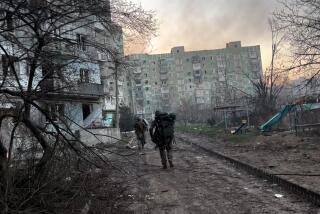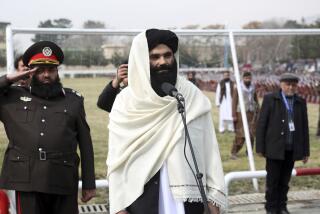To Many, Taliban Commander a Home-Grown Hero
- Share via
GARDEZ, Afghanistan — As bombs rained down and American forces seized a strategic ridgeline from a nest of Al Qaeda and Taliban holdouts in eastern Afghanistan on Thursday, details emerged about the veteran Taliban commander U.S. troops may be facing.
Rather than being an Arab import, Mullah Saifur Rahman Mansour is a lanky home-grown radical from Paktia province, where the battle is raging, officials and former comrades in the provincial capital of Gardez said.
That he is a native of the region, a commander respected both for his religious purity and sacrifices in past Afghan wars, may help explain the persistent reports that some Paktia residents have been rallying to his aid, even under withering fire from U.S. helicopters and gunships and deadly B-52 bombings.
It also helps illuminate how Rahman and his hard-line followers managed to remain relatively undisturbed in the mountains around here for nearly three months after the collapse of Taliban authority in most of the rest of Afghanistan.
“There are some people who say: ‘Saifur Rahman is a nice person. Why must we fight him?’ ” admitted Abdul Mutin, commander of one of Gardez’s U.S.-allied military brigades, who sits in the same office Rahman once used.
During Taliban rule, Rahman, who is thought to be about 40, was a commander on the northern front against the forces of the Northern Alliance.
His father, a mullah active in politics, was the governor of Paktia province and made his son a commander of one of the city’s three brigades. Later, his father was killed by a warlord. The young commander embraced the Taliban cause in the mid-1990s, a time when the fundamentalist movement was promising to put an end to the chaos caused by feuding warlords who were destroying and pillaging the country.
Safi Ullah, a spokesman for the local council, or shura, of Gardez, said Thursday that Rahman was wounded three times in three wars--against the Soviets in the 1980s, in the fighting among warlords of the early 1990s, and on behalf of the Taliban--and has a maimed hand as a result.
“He is famous in his native place, among his people, but now people don’t really like him because he has stood against the interim government,” Safi Ullah said. “The shura of Gardez asked him in the first days after the fall of the Taliban to surrender and not to gather people around him against the government. But he did it anyway.”
According to Safi Ullah, Rahman initially pretended when he withdrew to the mountainous Shahi Kot district that there were no Al Qaeda members with him, only Afghans.
The shura urged him to lay down his weapons and accept an amnesty like many other Taliban commanders had done. But, the council spokesman said, Rahman continually delayed and refused until it was later revealed that Arab and Pakistani Al Qaeda members had been accompanying him all along.
“After that, we did not want to negotiate with him any more because he had deceived the council,” Safi Ullah said. “So, no more negotiations as of two months ago.”
Fazlullah, the governor of neighboring Lowgar province, said Rahman had a distinguished reputation as a moujahedeen. He said he had been puzzled why Rahman and his followers didn’t change sides when other Taliban commanders were doing so in November and December, and give support to the new interim government being formed by Hamid Karzai.
“Maybe it is because their minds were brainwashed under the . . . rule of the Taliban. Or maybe the foreign [Al Qaeda] have been forcing the Afghan Taliban with them to stand against the government,” said Fazlullah, who uses only one name.
A third possibility, he said, is that Rahman considers himself bound by a personal pledge of honor he gave to the Al Qaeda members to protect them at all costs.
Officials in Gardez indicate that some contacts with Rahman had occurred as recently as last week, just before the U.S.-led assault on the mountain redoubts began Saturday. Rahman apparently asked the Gardez shura to send a delegation to him so that he could prove that he was not still sheltering foreign Al Qaeda members.
But the council, already convinced that Rahman was indeed with the “terrorists,” refused, Paktia Gov. Taj Mohamad Wardak told Reuters.
Nevertheless, there remains considerable ambiguity about how much of the force resisting the Americans is Al Qaeda members and how much of it is simply local Afghans.
As frigid storm clouds shrouded the high mountain passes of eastern Afghanistan on Thursday, U.S. military officers said their forces had attained overwhelming ground and air superiority.
Maj. Timothy Brooks, an operations officer at the Soviet-built Bagram air base that now serves as U.S. headquarters for the operation, said components from three battalions of American forces--about 1,000 troops--have managed to secure high ground on the eastern ridge overlooking the Shahi Kot valley.
The severe weather descending on the 10,000-foot-high battleground will limit the air support that Americans had enjoyed in the first six days of Operation Anaconda.
But Brooks dismissed the weather’s effect on U.S. operations. “If anything, the weather is an advantage for us,” he said. “Our guys are fit, and we are operating at will up there.”
After a costly start in the campaign with the death of eight U.S. servicemen in the first three days, the Army command in Bagram has become increasingly confident that the battle has turned in its favor. Brooks said that in the 14-hour period ending Thursday night, the coalition forces had had no direct contacts with the enemy.
But Lt. Joe Claburn, 25, an officer in charge of dropping food supplies to troops deployed along the ridgeline overlooking the Shahi Kot valley, said his Chinook helicopter was the target of heavy gunfire from a distant mountainside when it began to lift off after unloading Thursday. The supply drop was made on a mountain ridge called “The Whale” that looks down on the valley.
Claburn, a native of Montgomery, Ala., who has been in Afghanistan since November without seeing combat, said he took it as a welcome sign that his infantry unit has finally gone to battle.
“This is one of the best days of my life,” he said. “When the Chinook came over the ridgeline and we saw all the American troops in position, it was a beautiful sight.”
Officials said that U.S. officers and troops from the 10th Mountain and 101st Airborne divisions continue to explore the labyrinth of caves they have captured so far, looking for intelligence on Al Qaeda and Taliban activities.
There has been no word however about Rahman. A report on the Afghan Islamic Press, a Pakistani news agency, quoted him as saying that he intends to fight to the death.
More to Read
Sign up for Essential California
The most important California stories and recommendations in your inbox every morning.
You may occasionally receive promotional content from the Los Angeles Times.










